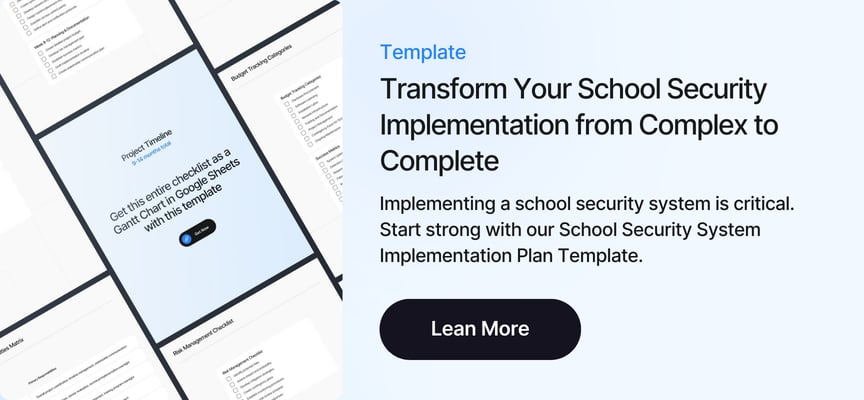For public school administrators, enhancing campus security with AI-powered video surveillance is increasingly essential - but navigating funding options can be complex. This comprehensive guide explores various funding pathways to help you transform your existing camera infrastructure into an intelligent security system that better protects your school community.
Key Points
- Multiple funding sources are available, from federal grants to local bonds
- AI security software can often utilize existing cameras, reducing hardware costs
- Creative budgeting approaches can help make advanced security accessible
- Partnership opportunities can extend limited resources
- Return on investment comes through enhanced safety and reduced security costs
Understanding the Investment
Before exploring funding options, it's important to understand what you're investing in. AI security camera software like VOLT transforms your existing surveillance infrastructure into an intelligent monitoring system without requiring expensive hardware replacements. This approach typically offers:
- Lower upfront costs compared to full system replacement
- Reduced ongoing personnel costs through automation
- Enhanced detection capabilities for multiple threat types
- Faster emergency response times
- Better utilization of existing security resources
Primary Funding Sources

1. Federal Grants
Several federal programs provide funding for school security improvements:
- Department of Homeland Security (DHS) Nonprofit Security Grant Program: Offers up to $200,000 per site for security enhancements
- COPS School Violence Prevention Program (SVPP): Provides funding for security equipment and technology
- Elementary and Secondary School Emergency Relief Fund (ESSER): Can be used for safety improvements
- Project SERV Grant Program: Available for schools that have experienced traumatic events
Federal grants often represent the most substantial funding opportunity for school security improvements. The DHS Nonprofit Security Grant Program, for instance, can provide up to $600,000 total for qualifying districts with multiple campuses. These funds can be specifically allocated for AI-powered security solutions, including software upgrades to existing camera systems.
The COPS School Violence Prevention Program offers another significant pathway, with a specific focus on technology that improves school security. This program particularly values solutions that can demonstrate measurable improvements in emergency response times and incident prevention – making it well-suited for AI security camera software implementation.
ESSER funds, while broadly targeted at school improvements, have specific provisions for enhancing school safety and security. Districts have successfully used these funds to upgrade their security infrastructure, including the implementation of advanced monitoring systems that help ensure student safety during both normal operations and emergency situations.

2. State-Level Funding
Many states have dedicated programs for school safety:
- State safety grants programs
- School security infrastructure funds
- Technology modernization initiatives
- Emergency preparedness allocations
Check with your state's Department of Education for specific programs available in your area.
State-level funding often provides more flexible implementation timelines and requirements compared to federal grants. Many states have established dedicated school safety grant programs in recent years, specifically designed to help schools implement modern security solutions. These programs frequently prioritize projects that maximize existing infrastructure while adding new capabilities – making them ideal for AI security camera software upgrades.
The application process for state funds typically involves working directly with your state's Department of Education or Department of Public Safety. Many states provide technical assistance during the application process and can help you align your security enhancement plans with state-specific requirements and priorities.
States also often combine security funding with broader technology modernization initiatives, allowing schools to implement comprehensive solutions that address both security and educational technology needs. This approach can be particularly valuable when implementing AI-powered systems that require robust network infrastructure.

3. Local Funding Options
District-level approaches include:
- School Safety Bonds: Community-supported funding for security improvements
- Capital Improvement Budgets: Allocation of existing infrastructure funds
- Technology Levies: Special tax assessments for school technology
- General Fund Reallocation: Strategic budget adjustments to prioritize security
Local funding options often provide the most direct path to implementing security improvements, as they typically involve fewer regulatory requirements than state or federal funding. School safety bonds, in particular, have seen high success rates in recent years as communities increasingly prioritize student safety. These bonds can be structured to cover both immediate security needs and ongoing system maintenance and updates.
Capital improvement budgets and technology levies offer opportunities to integrate security enhancements into broader infrastructure improvements. This approach can be particularly effective when presenting AI security camera software as part of a comprehensive modernization strategy that enhances both safety and operational efficiency.
Many districts have also found success through strategic reallocation of general fund resources, particularly when they can demonstrate how AI-powered security solutions can reduce long-term costs through improved efficiency and reduced need for security personnel overtime. The key to success with local funding often lies in clearly communicating both the immediate security benefits and long-term cost advantages to stakeholders.

4. Alternative Funding Strategies
Creative approaches to secure necessary resources:
- Public-Private Partnerships: Collaboration with local businesses or organizations
- Community Foundations: Local charitable organizations supporting school safety
- Insurance Premium Reduction: Security improvements may lower insurance costs
- Shared Services Agreements: Partnering with other districts or agencies
Alternative funding strategies can help bridge gaps when traditional funding sources aren't sufficient. Public-private partnerships have become increasingly common, with local businesses and organizations contributing to school safety initiatives. These partnerships often extend beyond financial support to include technical expertise and implementation assistance.
Community foundations and local charitable organizations frequently maintain funds specifically dedicated to school safety improvements. These organizations can be particularly valuable partners as they often have established relationships with multiple donors and can help coordinate larger community-wide support for security initiatives.
The Impact on Insurance
Insurance providers have also begun recognizing the value of AI-powered security systems in reducing risk. Many schools have successfully negotiated reduced premium rates based on enhanced security measures, effectively offsetting some of the costs of implementation.
When it comes to school safety and security, effective risk management practices can have a significant impact on both campus protection and insurance costs. Good insurance providers emphasize a three-step approach: identifying potential risks through comprehensive campus assessments, assessing the likelihood and impact of these risks, and actively addressing them through prevention measures.
This proactive stance includes regular evaluation of near-misses, participation in safety committees, and thorough review of contracts and security certificates. The relationship between risk management and insurance premiums is straightforward but powerful: better risk management leads to fewer claims, which attracts more insurers and ultimately results in better coverage options and more competitive rates.
Schools that demonstrate robust security measures and risk mitigation efforts often benefit from more favorable insurance terms, particularly when they engage in early renewal planning and maintain relationships with multiple insurers.
Beyond the financial benefits, effective risk management directly impacts the safety and wellbeing of students, faculty, and staff. Insurance providers recognize that each incident affects more than just the bottom line – it has real implications for the school community.
By implementing comprehensive security measures and maintaining detailed documentation of prevention efforts, schools can create safer environments while simultaneously reducing their insurance costs and improving their coverage options.
Read the Complete Guide: The Future of School Security in the Modern Era
Making the Case for AI Security Software
Successfully securing funding for AI security software requires a compelling presentation of its benefits and value proposition. When approaching decision-makers or completing grant applications, focus on demonstrating both the immediate security enhancements and long-term cost advantages that AI-powered systems provide.
When requesting funding, emphasize these key benefits:
1. Cost Efficiency
- Leverages existing camera infrastructure
- Reduces manual monitoring requirements
- Lowers ongoing operational costs
- Maximizes return on current security investments
2. Enhanced Safety Capabilities
- Time of incident notification
- Faster emergency response
- Comprehensive facility monitoring
- Proactive incident prevention
3. Resource Optimization
- Better utilization of security personnel
- Reduced false alarms
- Streamlined incident reporting
- Improved emergency coordination
Visit the full school security system funding resource center.
Budgeting Strategies
Implementing AI security camera software doesn't have to strain your current budget – strategic planning and phased implementation can help make costs manageable. By taking a thoughtful approach to deployment and carefully considering all cost elements, schools can create a sustainable funding model that works within existing constraints.
Phased Implementation
Breaking down the implementation of AI security software into distinct phases helps make the project more manageable both operationally and financially. This graduated approach allows schools to demonstrate success in high-priority areas before expanding coverage, while spreading costs over a longer period.
Consider a graduated approach to implementation:
1. Initial Phase
- Pilot program in high-priority areas
- Basic AI capabilities deployment
- Staff training and adaptation period
2. Expansion Phase
- Additional camera integration
- Enhanced feature activation
- Broader facility coverage
3. Full Implementation
- Complete system integration
- Advanced analytics deployment
- Comprehensive security protocols
GET THE TEMPLATE: Download our School Security System Implementation Plan Template
Cost Considerations
Understanding the full scope of expenses involved in implementing AI security camera software is crucial for accurate budgeting and funding requests. While the initial software investment is important, several other factors contribute to the total cost of ownership and should be included in your financial planning.
Account for all aspects of implementation:
- Software licensing fees
- Integration services
- Staff training
- Ongoing maintenance
- Technical support
- System updates

Building Your Funding Proposal
A successful funding proposal tells a compelling story about your school's security needs while presenting a clear, data-driven plan for addressing them. Whether you're applying for grants or requesting local funding, your proposal needs to demonstrate both the necessity of AI-powered security and your readiness to implement it effectively.
→ GET THE TEMPLATE: Download our AI-Powered Security Implementation Funding Proposal Template.
Essential Elements
A comprehensive funding proposal must include several key components to effectively communicate your security enhancement plans. These elements work together to create a complete picture of your current needs, proposed solution, and expected outcomes.
1. Needs Assessment
- Current security gaps
- Specific safety concerns
- Risk analysis findings
- Incident history
2. Solution Overview
- Proposed AI capabilities
- Implementation timeline
- Expected outcomes
- Success metrics
3. Budget Breakdown
- Detailed cost analysis
- Multi-year projections
- Operational savings
- Return on investment
4. Impact Analysis
- Safety improvements
- Operational benefits
- Community impact
- Long-term valueRead the Case Study: How a Public High School Transformed School Securi
Read the Case Study: How a Public High School Transformed School Security
Implementation Timeline
A clear, realistic timeline helps stakeholders understand the deployment process and sets appropriate expectations for system activation. Breaking down the implementation into specific phases with defined milestones ensures smooth execution while maintaining accountability.
A typical deployment schedule:
1. Month 1-2
- Funding secured
- Initial planning
- Stakeholder engagement
2. Month 3-4
- System integration begins
- Basic training conducted
- Pilot area activation
3. Month 5-6
- Full deployment
- Advanced training
- Protocol refinement
4. Ongoing
- Performance monitoring
- Regular updates
- Continued optimizationGET THE TEMPLATE: Download our School Security System Implementation Plan Template
Conclusion
Securing funding for AI security camera software requires a strategic approach that leverages multiple sources and demonstrates clear value to your school community. By understanding available options and building a comprehensive funding strategy, you can make this important security enhancement accessible for your district.
Remember that investing in AI-powered security isn't just about technology – it's about creating a safer environment where students and staff can focus on education. The right funding approach can help make this vital security upgrade achievable within your budget constraints.
Contact VOLT AI to learn more about how we can help you develop a cost-effective security solution that meets your district's needs and budget requirements.





